Calme is an app that helps university students with stress management through one-on-one counseling. Users are free to post their questions or concerns and consult with a trained professional in a private setting.
Try out our interactive prototype below
↓
According to 2013 National College Health Assessment, about one-third of U.S college students had difficulty functioning because of stress and almost half of them responded that they felt overwhelming anxiety during school years. Existing mental health services are underutilized. Therefore, an effective assistive technology for stressed college students is in high demand.
How can a technology effectively help college students manage stress?
Create an assistive technology that would easily and effectively help students to manage stress.
Through online surveys and user interviews, we wanted to understand how often and to what extent students felt stressed and how they dealt with it. To achieve this goal, our mission could be defined by three elements: one is understanding the common strategy that students use to destress. Second is knowing what concerns might rise when technology was involved in the process of helping students to feel better. Last is to understand what would be the better means for young generations to reach out for help when they needed help.
Our goal for the survey was to understand what stressed students out and how they dealt with stress. Thus, we have created a survey focusing on people’s opinions on stress and health lifestyle along with background questions to help us understand more about our demographics. We also reached out to our friends from other universities across the to spread the survey so that we could have more diverse responses.
We created questionnaires using Google forms and sent out the questionnaire to college students, who were our intended target audiences, as well as those who could help to distribute the survey via emails and Facebook groups. We were able to get the data from different universities and colleges across the countries thanks to our friends.

We have received 142 responses in total. The data helped our in-person interviews designing process.
The purpose of user interviews was to understand how students dealt with stress in depth. We conducted in-person interviews in places where participants would use technologies when they were stressed. It’s always helpful to simulate the scenario and let interviewees express their true feelings.
Goals: to find out when/where/what/how stressed college students interact with technologies.

Target Audiences
Stressed college students who have basic knowledge of using technologies.
Biography of Participants
We recruited 5 participants aged from 18 to 24 through emails and postings. Of those participants, 2 were males and 3 were females.
Affinity Diagram
We created an affinity diagram using the data we collected from both surveys and interviews to find common patterns and themes across users. This helped us to form our personas.

Goal: to create reliable and realistic representations of the key audience segments for reference.
Primary
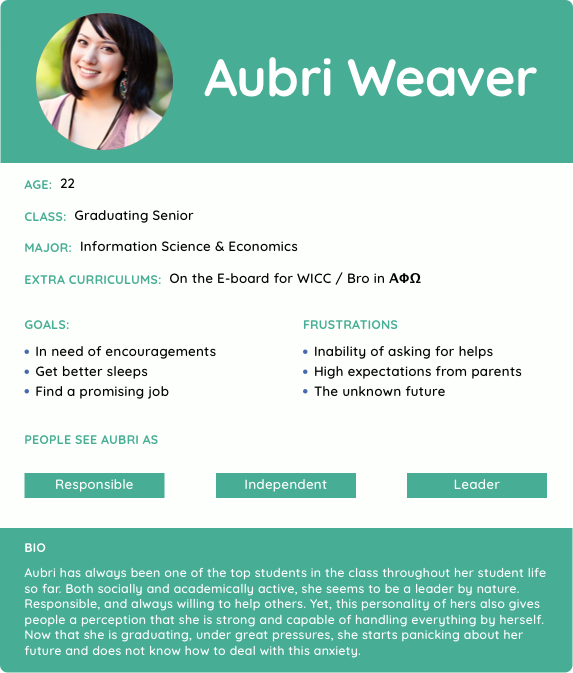
Secondary

There are many ways to relieve stress. Exercises, talking with people, venting emotions, or even a nice dinner can do the trick. In this project, we focused on the emotional support and its role in stress management. To better understand areas of opportunities for stress management technologies, I conducted a competitor analysis on different applications and services.
Chat
Some existing applications, such as Kindly, Thrive, and Let’s Talk, allow stressed individuals to talk to a professional counselor directly for helps. This feature is useful in a way that the information is coming from a credible source. Also, some users could get reference on how to deal with stress. But these apps cannot help everyone to manage their stress since everyone stresses about different issues.
Vent
Other applications, such as YikYak, Vent, and Whisper, allow users vent out their emotions anonymously. This feature gives users more privacy and freedom to express themselves. While users feel comfortable relieving their stress via a free-to-say-anything channel, the words in the app could sometimes get aggressive and it turn hurt other users.
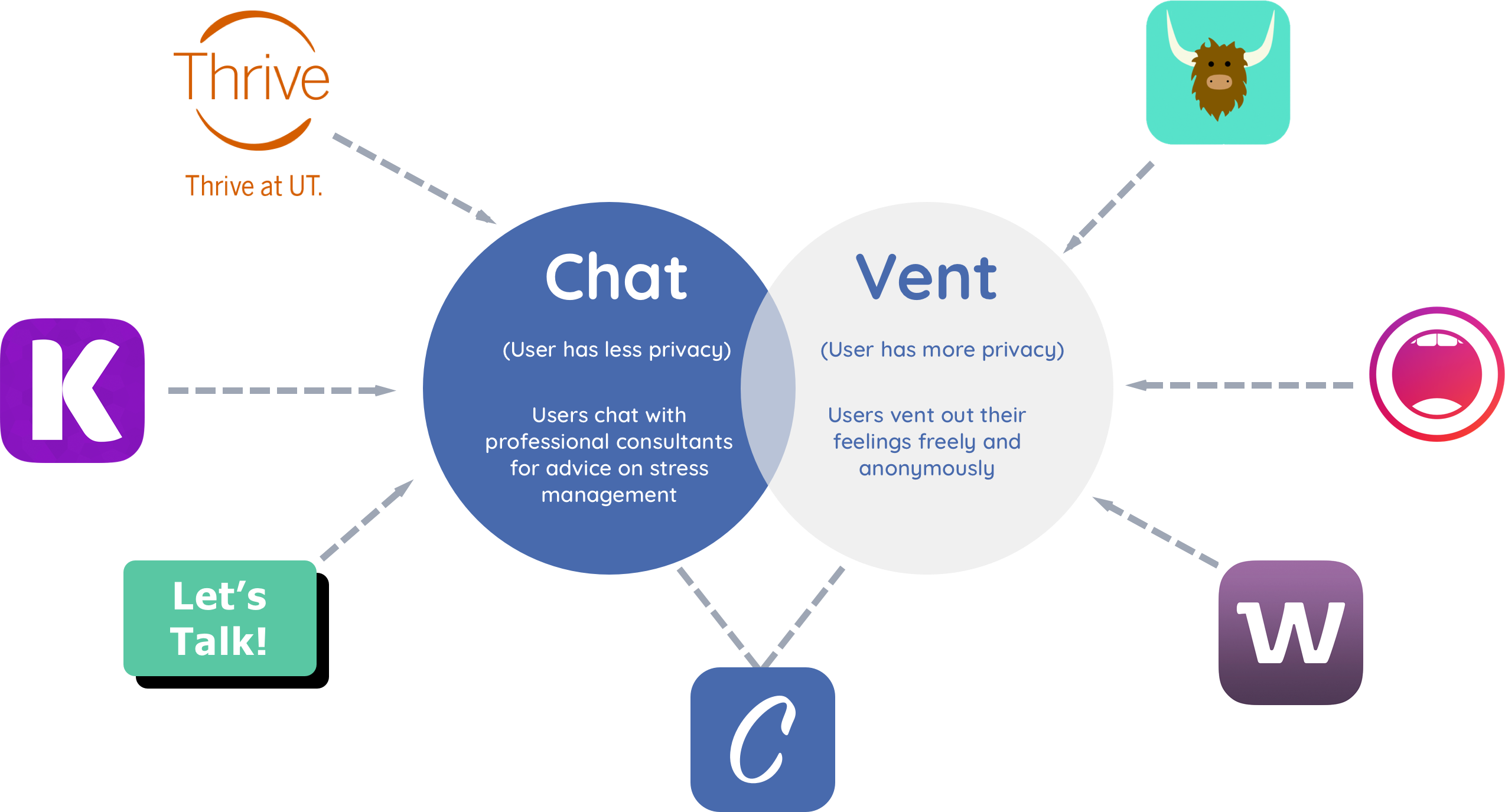
Combing the data we gathered from user research and market research, we were able to identify pain points and findings that pushed our design process forward.

After the brainstorm session, we came up with the idea of creating a school-location-based applications for students to vent/speak out their problems anonymously as well as receive help from fellow students. By making it a school-location-based application, it will ensure that all users are students currently enrolled in the same university. This would make feeling empathy for other easier because of the similar hardship that only students at the same university would understands.

User Testing & Evaluation Interviews
We conducted a brief user testing and another round of user interviews to study users’ preferences on venting or chatting to relieve stress.
In addition, to better understand our users, we consulted with the university’s health center and mental health services (EARS - Empathy, Assistance, and Referral Services) since they have the most experiences with students who fit our primary personas.
Some key insights we learned are:
Users
Professionals
The feedback we got made us rethink our approach to the problem. Instead of creating a feature that might be rarely used by users, we were forced to think of a way to incorporate a more private and personal channel to help with users’ stress management.
Based on the findings, we created our second iteration.
During this version, we introduced the concept of “Calmee”, the users, and “Calmer”, the EARS student counselors.
Calmee & Calmer
This feature allows users to choose whom to talk to. They can either get help from a trained counselor or from a larger sample of people who might have undergone similar situations
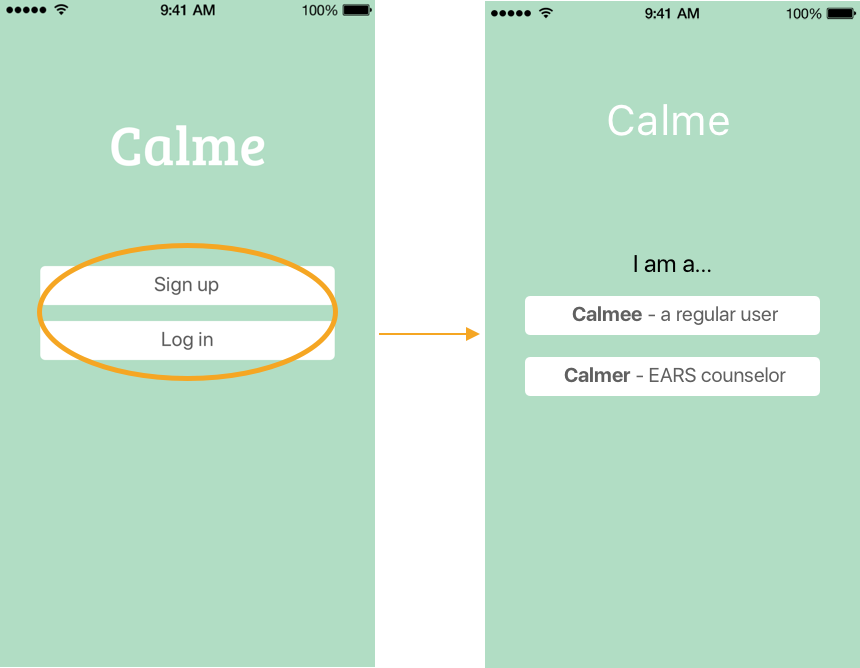
Removal of “Vent” and “Question” tab at the top to create one smooth scroll action
During our testing session, some users expressed their concerns of not knowing what tab they were under and what if the post was both a vent and a questions
Instead, we added tags (a vent, a question, or both) on the upper left corner of each post
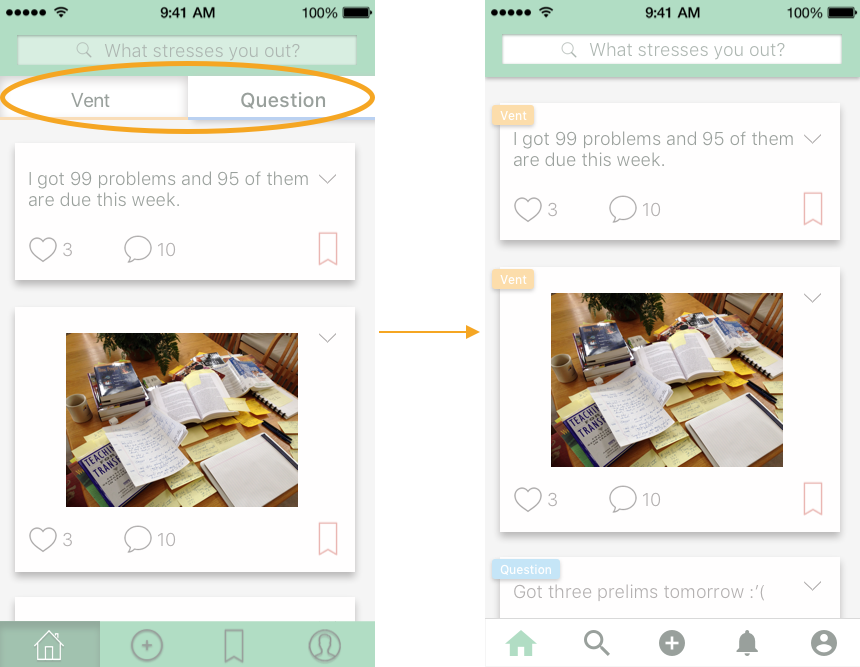
Options to strictly post to public or to the Calmers for help
This feature allows users to choose whom to talk to. They can either get help from a trained counselor or from a larger sample of people who might have undergone similar situations
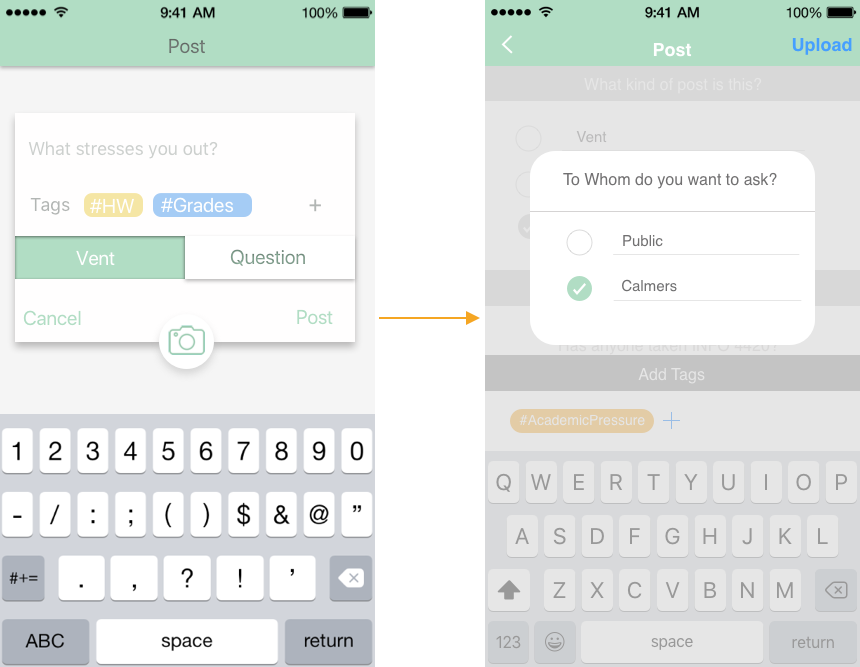
Direct Messaging between users and counselors
Introduced direct messaging for each post to encourage more one-on-one and interpersonal personal between users who were seeking for help and who were helping.
Both users and Calmers were able to reply to a post through direct message. Yet only calmers could reply to a post if it was directly posted to calmers
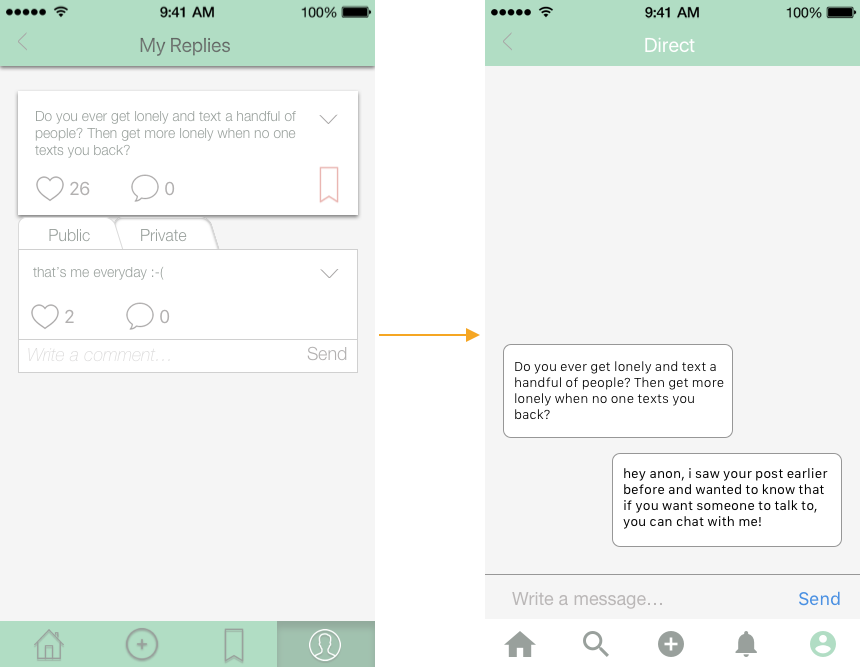
User Testing & Evaluation Interviews

For this iteration, we conducted another round of user testing with both students and EARS counselors and interviewed our users to evaluate our design as we were trying to develop our applications through multiple iterations. We wanted to make sure the changes we made actually brought users closer to their goals/needs that was initially requested.
After our testing and review sessions with our users and student counselors, we figured there were a few usability hiccups throughout our application.

Based on the previous feedback and testing results, we made a final round of iteration.
Feature hightlights
After removing the community feature, the content of what users have posted are only accessible to the users themselves and the counselors who would be helping them.
A conversation would be automatically initiated as users post something new. A pop-up prompt would let the users how long it usually take to get a response from a counselor.
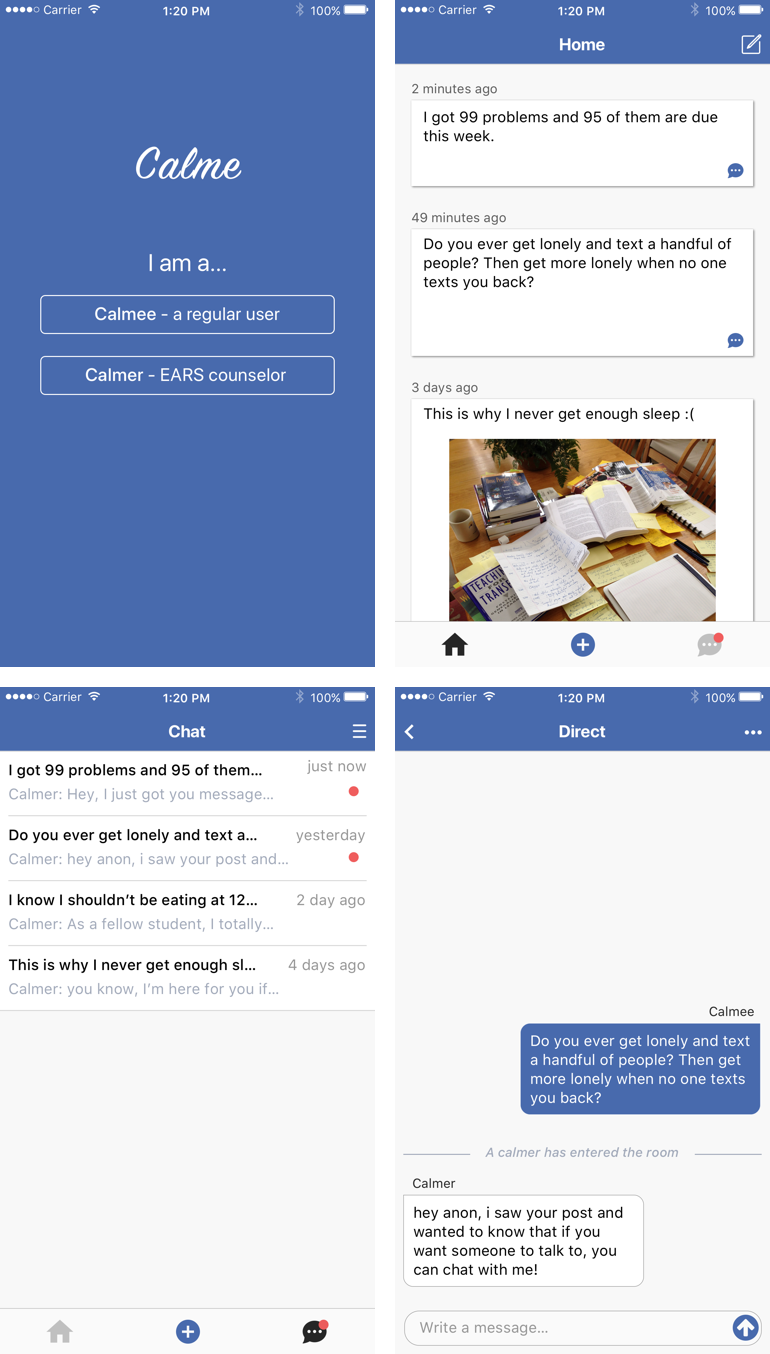
Feature hightlights
To ensure all calmers (counselors) are certified EARS counselors, we made sure to require photo evidence of the certificate they received upon the completion of their trainings when registering to be a counselor on the application.
Once a conversation is ended by a calmee, to respect the regular users’ privacy, it would be deleted from calmer’s chat history. This would replicate the idea of “what’s said in the room, stays in the room” because there would be no lingering evidence from past conversations.
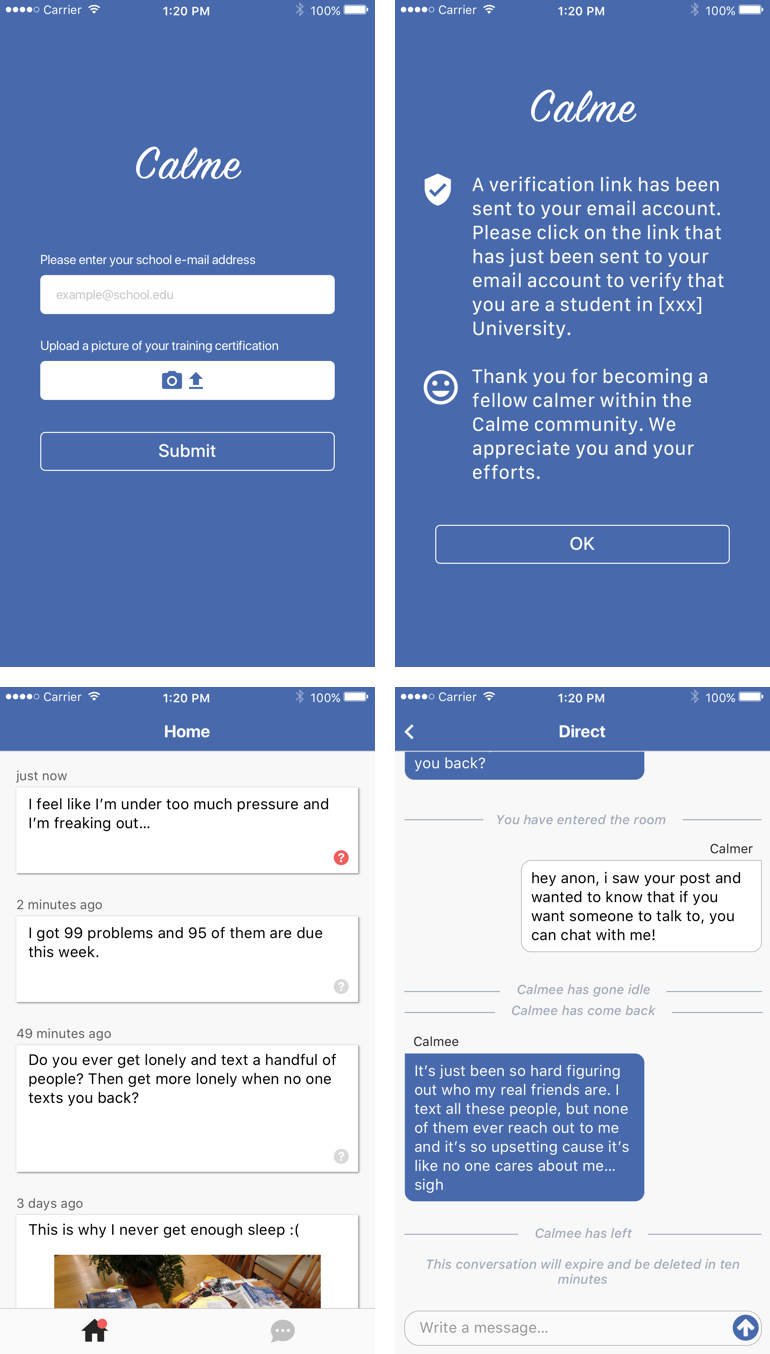
We also made sure to limit the number of tabs to the minimum for in our navigation bar to only have the main functions of the applications:
Upon completing our final design, we realized there were still many details that we have not thought of or needed reconsidered.
To make this mobile application better in the future, we would want to complete more iterations from user feedback and testing results. Some additional features we would consider are:
The biggest challenge we encountered during this project is that we had a hard time figuring out what the core of our app was. Since the first iteration, our professor has questioned about the core of the app. Not the main feature, but the core. At that time, I didn’t quite understand what he meant. However, as we began to narrow down our topic, we realized we were trying to solve a huge problem with one app by putting many features together. As a result, a lot of the features we thought might be useful to users were actually unattended during user testings. When we limited our feature to posting and chatting with a counselor, the usability of the app arose. This made me realize that a good design is not about putting all possible solutions from user research into the product and expects users to find the one that suits them. On the contrary, a good design is about how a particular solution solves user's problems regardless of where they come from.